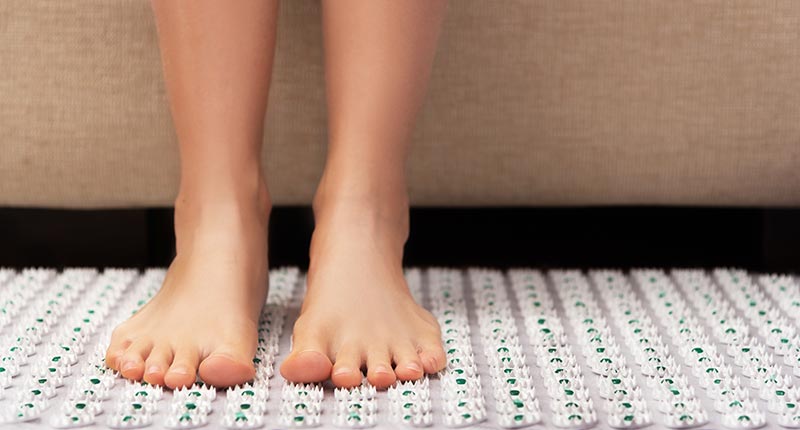Thyroid disease is very common and may not come to you as a result of your lifestyle. You are at risk of having thyroid disorder if it’s in your family history. However, you can avoid thyroid by knowing and massaging the acupressure points for thyroid problems.
In the United States, about 20 million people have some form of thyroid disorder. In Taiwan, the thyroid attack rate is very high. It is second after diabetes.
Thyroid diseases mostly occur as a result of the over-functioning (hyperthyroidism) or under-functioning (hypothyroidism) of the thyroid gland.
In this article, I’ll show you the acupuncture points for hyperthyroidism and hypothyroidism that allow for better functioning of the thyroid. But first, let’s answer some questions you may already be asking.
What Is Thyroid?
The thyroid is a gland in the front of the neck that looks like a butterfly. It is located below your Adam’s apple, wrapped around the front of the windpipe. It has two side lobes that are connected in the middle by a bridge or isthmus. In its normal size, you can’t feel the thyroid.
As it is brownish-red in color, the thyroid is filled with blood vessels, and the nerves that aid voice quality pass through it.
What Is The Role Of The Thyroid Play In The Body?

The thyroid is responsible for releasing and controlling thyroid hormones in your body that controls metabolism. Metabolism involves the transformation of food in the body to the energy that keeps most of your body systems working satisfactorily.
Generally, thyroid:
- Stimulates your heartbeat, aiding your breathing.
- Promotes gastrointestinal movement
- Accelerates neuromuscular response
- Stimulates the production of heat in your body as well as oxygen utilization
- Promotes bone metabolism
- Enhances autonomic nerve function.
What Are The Common Thyroid Defects?
When your thyroid gland fails to function properly, you risk having any of the following deficiencies:
- Goiter: An iodine deficiency that leads to the swelling of your thyroid.
- Thyroiditis: An inflammation of the thyroid that comes from a viral infection or an autoimmune condition.
- Hyperthyroidism: The excessive production of thyroid hormone production, which is mostly triggered by Graves disease or an overactive thyroid nodule.
- Hypothyroidism: The low production of thyroid hormone, which is mostly caused by an autoimmune disease.
- Graves disease: An autoimmune condition characterized by overstimulation of the thyroid and leading hyperthyroidism.
Is Acupuncture Good For Thyroid?

Yes, acupuncture is good for treating thyroid disorders. Traditional Chinese medicine sees hyperthyroidism and hypothyroidism as an imbalance of Yin and Yang imbalances. Therefore, Acupuncture, effective therapy for rebalancing Yin and Yang, is suitable for treating Thyroid.
Several studies corroborate this. One such study is the Shanghai Medical University study that found that symptoms of hypothyroidism improved significantly when treated with a Chinese herbal preparation to stimulate the kidney energy channel.
This confirms the connection between hypothyroidism and a deficiency in kidney energy, as well as solidifies my reason for showing you the thyroid acupuncture points.
Is Ginger Good For The Thyroid?
Yes, ginger can help thyroid conditions as it is rich in minerals like potassium and magnesium. Also, ginger helps combat inflammation which is the primary cause of thyroid issues.
So, ginger products like ginger tea and ginger oil can be used to relieve thyroid conditions.
Acupoints For Hyperthyroidism Or Hypothyroidism

Before I show you specific acupuncture points for hyperthyroidism that regulate mood, rapid heart rhythm, immunity, ad metabolism, I’ll tell you about the thyroid point.
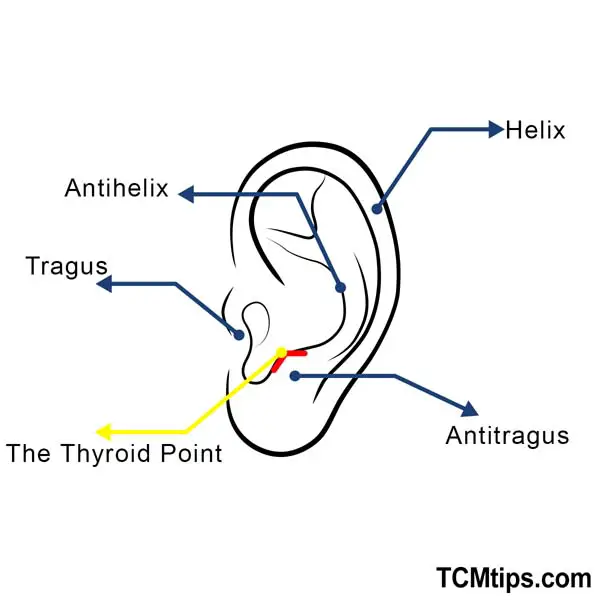
The thyroid point is a special acupuncture point on the ear that traditional Chinese medicine has identified for the treatment of both hyperthyroidism or hypothyroidism.
This acupressure point for thyroid problems is located at the intersection of the tragus and the antitragus. It is the sharp protrusion just below the “ringing notch” indicated by the yellow arrow in the picture above.
If your thyroid gland is abnormal, pressing this thyroid acupuncture point will feel as painful as a tear, but it will relieve your symptoms. You can also press the thyroid point when walking or swelling your calves, then breathe again so you don’t wheeze so much.
Acupuncture Points For Hyperthyroidism To Regulate Mood And Rapid Heart Rhythm
When it comes to regulating your mood and the rhythm of your heart, two acupressure points for thyroid conditions are very important.
#1. Acupoint: HT-7 (Other Names: Heart-7/Shen Men/Spirit Gate)
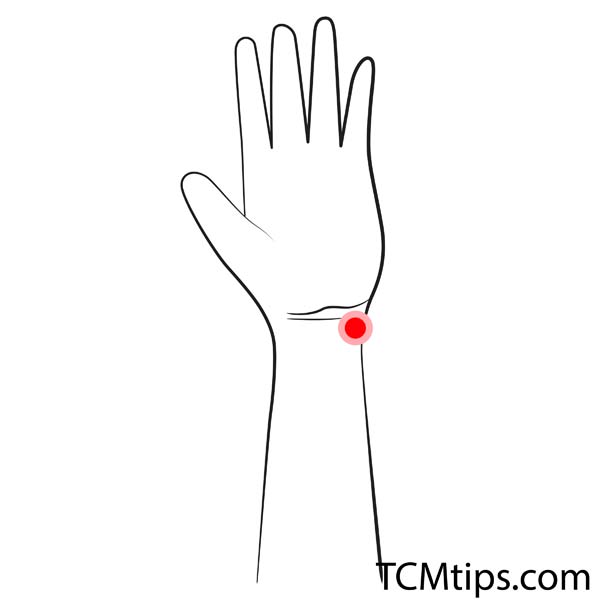
The HT-7 acupressure point is called Shenmen in Chinese or Gate of the Spirit in English. It is the 7th acupoint of the heart meridian. This acupoint is located at the wrist crease, on the radial side of the flexor carpi ulnaris tendon. It is between the ulna and the pisiform bones.
As the spirit gate, HT-7 is the access to your spirit, mind, or emotion. Hence, rubbing this acupressure point for thyroid issues will open the door to relieve the blockage of energy from the spirit, mind, or emotion.
Because of this, Shenmen is used to treat disorders like amnesia, stupor, mania, insomnia, palpitations from fright, irritability, and chest pain.
#2. Acupoint: PC-6 (Other Names: Pericardium-6/Nei Guan/Inner Pass)
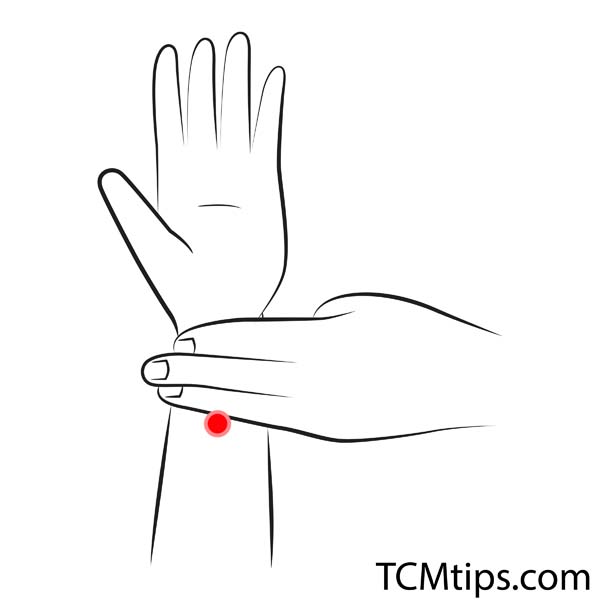
Acupoint PC6 is called Nei Guan in Chinese or Pericardium 6 in English. It is located below the wrist on the inner forearm, three finger breadths between the two tendons. You can easily find this acupuncture point for hyperthyroidism by turning your hands over such that your palm is facing up.
PC6 is effective in relieving the symptoms of nausea, stomach upset, motion sickness, carpal tunnel syndrome, and headaches. Research shows that PC6 acupoint stimulation significantly reduced the incidence of nausea, vomiting, and the need for rescue antiemetics in 7667 participants.
Also, PC-6 is of the three heart pressure points that relieve heart problems.
To improve thyroid function using PC-6, apply downward pressure between the two tendons. Massage and stimulate the area for 4-5 seconds.
Acupuncture Points For Hyperthyroidism To Regulate Immunity And Metabolism
You can boost your immunity and regulate your metabolism with the following acupuncture points for hyperthyroidism:
#1. Acupoint: ST-36 (Other Names: Stomach-36/Zu San Li/Leg Three Miles)

ST-36 is known as Zu San Li in Chinese and Leg Three Miles in English. This acupressure point is located at about four finger widths down the bottom of your knee cap, along the outer boundary of your shin bone. When you lock in on this acupoint and move your foot up and down, a muscle pops out.
The Leg Three Miles acupressure point is known for treating gastrointestinal discomfort; nausea and vomiting; stress; and fatigue. Research also reveals that massaging this acupressure point for thyroid disorders has positive effects on brain function.
To activate ST-36, locate the point and apply downward pressure on the muscle around the area for four to five seconds.
#2. Acupoint: SP-6 (Other Names: Spleen-6/San Yin Jiao/Three Yin Intersection)
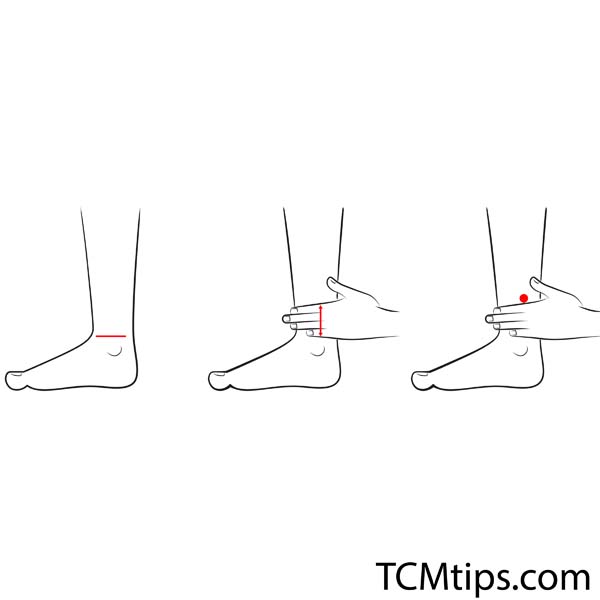
SP-6 is the 6th acupoint of the Spleen meridian. It is called San Yin Jiao in Chinese and Three Yin Intersection in English.
As the name implies, this acupuncture point is at the intersection of the triple meridian pathway, which is the kidney channel, the liver channel, and the spleen channel. It is found 3cm above the medial malleus. This point is at the highest peak of your ankle.
Known to control the reproductive organ, SP-6 is used clinically for urological issues, pelvic disorders, insomnia, and menstrual cramps. It is advised that SP-6 shouldn’t be used in pregnancy because it induces labor. However, research conducted at the Trabzon Maternity Hospital in Turkey shows that acupressure is effective in decreasing pain and duration of labor.
To activate this thyroid acupressure point, move four finger widths up your leg, apply deep pressure slightly behind the bone (tibia, and massage the area for up to five seconds.
#3. Acupoint: KD-7 (Other Names: Kidney-7/Fu Liu/Returning Current)

KD-7 is the 7th of the Kidney meridian acupoints. The Chinese call it Fuliu, which means Returning Current or Recurrent Flow.
The location of KD-7 depends on first locating KD-3. You can find KD-3 halfway between the highest point of your medial malleolus, also known as the outer protrusion of your ankle, and the attachment of your Achilles tendon.
Once you’ve identified KD-3, KD-7 is two cun directly above KD-3. This means that Fuliu is located 2.5 inches above KD-3.
Clinically, this acupressure point for thyroid disorders is used to regulate the water passages in the body, treat edema, regulate sweating, drain Damp and clears Damp-Heat, and strengthen the lumbar region.

#4. Acupoint: Liv-3 (Other Names: Liver-3/Tai Chong/Supreme Rush)

Liv-3 is the third acupoint in the liver meridian. It is known as Tai Chong or Supreme Rush and is located on your foot, about two finger-widths above the intersection of the big toe and the next toe.
This thyroid pressure point is commonly used in the treatment of stress, lower back pain, high blood pressure, menstrual cramps, limb pain, insomnia, and anxiety. If you’re having anxiety problems, here are the five best massages for anxiety that you can do by yourself at home.
A study on Animals confirms that Liv-3 lowers blood pressure and plasma endothelin-1 levels in hypertension subjects.
To activate this thyroid acupoint for hyperthyroidism, take off your shoes; locate the point on your foot; and apply deep, firm pressure on the area for about five seconds.
 P. Sze
P. Sze 




